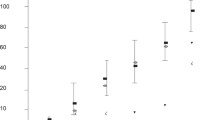Summary
Pregnancy associated plasma protein A (PAPP-A) was measured in maternal serum by electroimmunoassy in 414 women (with subsequent normal pregnancy outcome) during the 38th week of pregnancy. PAPP-A levels were examined in relation to maternal and fetal characteristics, revealing a statistically significant relationship with maternal weight, placental weight, fetal sex and gravidity. The correlation of PAPP-A levels to fetal sex and gravidity could not be explained by differences in placental or maternal weight. Mean levels of PAPP-A were also not significantly different in relation to fetal sex.
Similar content being viewed by others
References
Bischof P (1981) Pregnancy associated plasma protein A: An inhibitor of the complement system. Placenta 2: 29–34
Bischof P, Hughes G, Klopper A (1980) Relationship of obstetric parameters to the concentration of pregnancy associated plasma protein A. Am J Gynecol 138: 494–499
Folkersen J, Grudzinkas JG, Hindersson P, Teisner B, Westergaard JG (1981) Pregnancy associated plasma protein A (PAPP-A): Circulating levels during normal pregnancy. Am J Obstet Gynecol 139: 910–914
Hughes G, Bischof P, Wilson G, Klopper A (1980a) Assay of a placental protein to determine fetal risk. Br Med J 280: 671–673
Hughes G, Bischof P, Wilson G, Smith R, Klopper A (1980b) Test of fetal well being in the third trimester of pregnancy. Br J Obstet Gynecol 87: 650–656
Lin, TM, Halbert SP, Spellacy WN (1975) Relation of obstetric parameters to the concentrations of four pregnancy-associated plasma proteins of women in normal gestation. Am J Obstet Gynecol 125: 17–24
Sinosich MJ, Teisner B, Davey M, Grudzinskas JG (1981) Pregnancy associated plasma protein A: Interaction with heparin in crossed immunoelectrophoresis. Aust NZ J Med 11: 29–34
Sutcliffe RG, Kukulska-Langlands BM, Horne CHW, Maclean AB, Jandial V, Sutherland HW, Gibb S, Bowman AW (1982) Studies on the concentration of PAPP-A during normal and complicated pregnancy. Placenta 3: 71–80
Westergaard JG, Teisner B (1982) Pregnancy associated plasma protein A in normal and abnormal pregnancy. In: Grundzinskas JG, Sepälä M, Teisner B (eds) Pregnancy Proteins: Biology, Biochemistry and Clinical Application, Academic Press, Sydney, pp 345–356
Westergaard, JG, Hau J, Teisner B, Grudzinskas JG (1983a) Specific and reversible interaction between pregnancy associated plasma protein A and heparin. Placenta 4: 13–18
Westergaard JG, Sinosich MJ, Bugge M, Madsen LT, Teisner B, Grudzinskas JG (1983b) Pregnancy associated plasma protein A in the prediction of early pregnancy failure. Am J Obstet Gynecol 145: 67–69
Author information
Authors and Affiliations
Additional information
This work was supported by the Danish Medical Research Council (Grant No. 12-0094 and 121-1794) and Provinsbankens Studielegat
Rights and permissions
About this article
Cite this article
Westergaard, J.G., Teisner, B. & Grudzinskas, J.G. Serum PAPP-A in normal pregnancy: Relationship to fetal and maternal characteristics. Arch. Gynecol. 233, 211–215 (1983). https://doi.org/10.1007/BF02114602
Received:
Accepted:
Issue Date:
DOI: https://doi.org/10.1007/BF02114602



